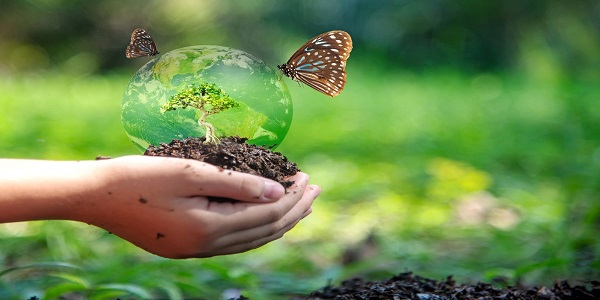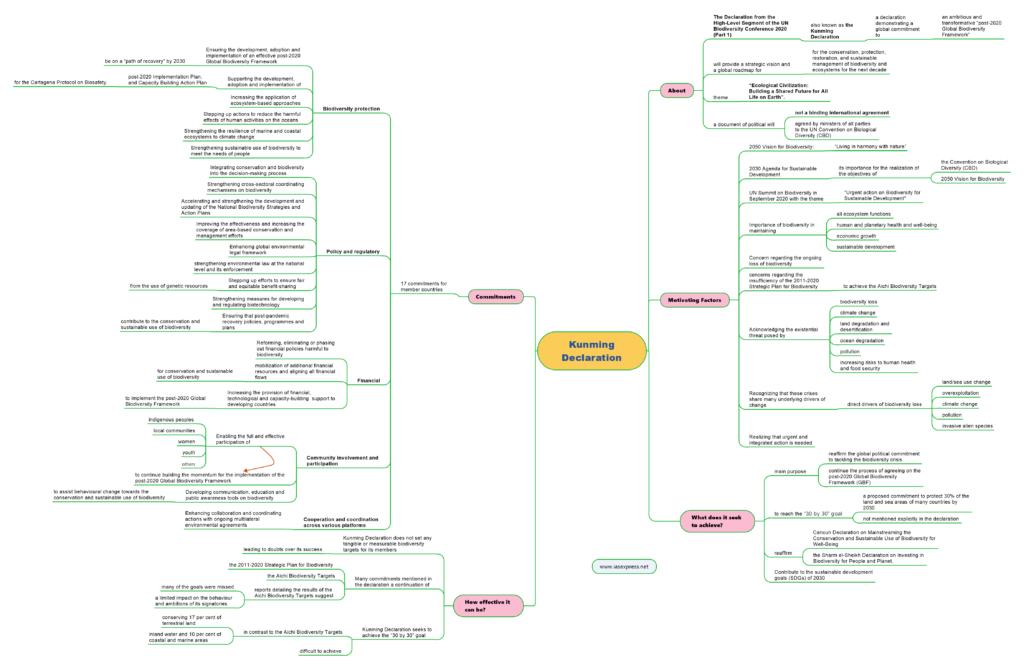Kunming Declaration – Goals and Commitments

From Current Affairs Notes for UPSC » Editorials & In-depths » This topic
IAS EXPRESS Vs UPSC Prelims 2024: 85+ questions reflected
More than 100 countries adopted the Kunming Declaration at the first part of the 15th meeting of the Conference of the Parties (COP15) to the United Nations Convention on Biological Diversity (CBD) held recently in Kunming, Yunnan Province, China.

About
- The Declaration from the High-Level Segment of the UN Biodiversity Conference 2020 (Part 1) also known as the Kunming Declaration is a declaration demonstrating a global commitment to an ambitious and transformative “post-2020 Global Biodiversity Framework”.
- It will provide a strategic vision and a global roadmap for the conservation, protection, restoration, and sustainable management of biodiversity and ecosystems for the next decade.
- The theme of this declaration is “Ecological Civilization: Building a Shared Future for All Life on Earth”.
- It is a document of political will, not a binding international agreement.
- The text is agreed by ministers of all parties to the UN Convention on Biological Diversity (CBD), which includes just about every country except the USA.
Motivating factors
- The 2050 Vision for Biodiversity: “Living in harmony with nature”.
- The 2030 Agenda for Sustainable Development and its importance for the realization of the objectives of the Convention on Biological Diversity (CBD) and the 2050 Vision for Biodiversity.
- The UN Summit on Biodiversity in September 2020, with the theme: “Urgent action on Biodiversity for Sustainable Development.”
- Importance of biodiversity in maintaining all ecosystem functions and human and planetary health and well-being, economic growth and sustainable development.
- Concern regarding the ongoing loss of biodiversity that may hamper achieving the Sustainable Development Goals (SDGs) and other international goals and targets.
- Recognising the progress made in the last decade, under the 2011-2020 Strategic Plan for Biodiversity but concerns regarding its insufficiency to achieve the Aichi Biodiversity Targets.
- Acknowledging the existential threat posed by unprecedented and interrelated crises of biodiversity loss, climate change, land degradation and desertification, ocean degradation, pollution, and increasing risks to human health and food security.
- Recognizing that these crises share many underlying drivers of change with the main direct drivers of biodiversity loss being land/sea use change, overexploitation, climate change, pollution and invasive alien species.
- Realizing that urgent and integrated action is needed to halt and reverse the loss of biodiversity and conserve and use it sustainably through a multisectoral approach and participation.
Commitments
The declaration outlines general targets for the restoration and protection of biodiversity and lists 17 commitments for member countries, urging both international collaborations on several issues and increased efforts at a domestic level.
- Biodiversity protection
- Ensuring the development, adoption and implementation of an effective post-2020 Global Biodiversity Framework to reverse the current loss of biodiversity and be on a “path of recovery” by 2030.
- Supporting the development, adoption and implementation of an effective post-2020 Implementation Plan, and Capacity Building Action Plan, for the Cartagena Protocol on Biosafety.
- Increasing the application of ecosystem-based approaches to address
- Biodiversity loss.
- Restore degraded ecosystems.
- Boost resilience, mitigate and adapt to climate change.
- Support sustainable food production.
- Promote health.
- Stepping up actions to reduce the harmful effects of human activities on the oceans to protect marine and coastal biodiversity.
- Strengthening the resilience of marine and coastal ecosystems to climate change.
- Strengthening sustainable use of biodiversity to meet the needs of people.
- Policy and regulatory
- Integrating conservation and biodiversity into the decision-making process through policies, regulations, planning processes, poverty reduction strategies and economic accounting.
- Strengthening cross-sectoral coordinating mechanisms on biodiversity.
- Accelerating and strengthening the development and updating of the National Biodiversity Strategies and Action Plans, to ensure the effective implementation of the post-2020 Global Biodiversity Framework at the national level.
- Improving the effectiveness and increasing the coverage of area-based conservation and management efforts to protect species and genetic diversity and reduce or eliminate threats to biodiversity.
- Enhancing global environmental legal framework and strengthening environmental law at the national level and its enforcement.
- Stepping up efforts to ensure fair and equitable benefit-sharing from the use of genetic resources.
- Strengthening measures for developing and regulating biotechnology to ensure equitable distribution of its benefits while minimizing their environmental impact.
- Ensuring that post-pandemic recovery policies, programmes and plans contribute to the conservation and sustainable use of biodiversity promoting sustainable and inclusive development.
- Integrating conservation and biodiversity into the decision-making process through policies, regulations, planning processes, poverty reduction strategies and economic accounting.
- Financial
- Reforming, eliminating or phasing out such financial policies that are harmful to biodiversity combined with the mobilization of additional financial resources and aligning all financial flows for conservation and sustainable use of biodiversity.
- Increasing the provision of financial, technological and capacity-building support to developing countries that are necessary to implement the post-2020 Global Biodiversity Framework.
- Community involvement and participation
- Enabling the full and effective participation of indigenous peoples and local communities, women, youth, civil society, local governments and authorities, academia, the business and financial sectors, and other relevant stakeholders to continue building the momentum for the implementation of the post-2020 Global Biodiversity Framework.
- Developing communication, education and public awareness tools on biodiversity to assist behavioural change towards the conservation and sustainable use of biodiversity.
- Cooperation and coordination across various platforms
- Enhancing collaboration and coordinating actions with ongoing multilateral environmental agreements to promote the protection, conservation and sustainable management and restoration of terrestrial, freshwater and marine biodiversity.
What does it seek to achieve?
- Its main purpose is to reaffirm the global political commitment to tackling the biodiversity crisis and continue the process of agreeing on the post-2020 Global Biodiversity Framework (GBF).
- Although not mentioned explicitly, the declaration seeks to reach the “30 by 30” goal.
- This goal stands for a proposed commitment to protect 30% of the land and sea areas of many countries by 2030.
- It seeks to reaffirm the Cancun Declaration on Mainstreaming the Conservation and Sustainable Use of Biodiversity for Well-Being and the Sharm el-Sheikh Declaration on Investing in Biodiversity for People and Planet.
- Contribute to the sustainable development goals (SDGs) agenda of 2030.
How effective it can be?
- The Kunming Declaration does not set any tangible or measurable biodiversity targets for its members leading to doubts over its success, fulfilment of its commitments and real action by the member countries.
- Many commitments mentioned in the declaration are a continuation of the 2011-2020 Strategic Plan for Biodiversity and the Aichi Biodiversity Targets.
- However, reports detailing the results of the Aichi Biodiversity Targets suggest that many of the goals were missed, indicating that the document had a limited impact on the behaviour and ambitions of its signatories.
- The Kunming Declaration seeks to achieve the “30 by 30” goal which is in contrast to the Aichi Biodiversity Targets and its commitment to conserving 17 per cent of terrestrial land and inland water and 10 per cent of coastal and marine areas.
- When the Aichi targets – being comparatively easier to achieve, have been difficult to achieve, the commitments of the Kunming Declaration will not be easier to be fulfilled.
Way forward
The signed declaration is due to be finalized and adopted at the second part of the COP15 in May 2022, after more formal negotiations in January 2022 and will be submitted to the General Assembly of the United Nations, the 2022 High-Level Political Forum on Sustainable Development, and the United Nations Environment Assembly. Thus, its effectiveness cannot be decided right now. However, one can hope that these commitments help the global community take concrete actions in the coming time ensuring sustainable development for all.
Practise Question
Q. What do you know about the UN Convention on Biological Diversity (CBD) and what are its targets? (250 words)
If you like this post, please share your feedback in the comments section below so that we will upload more posts like this.

